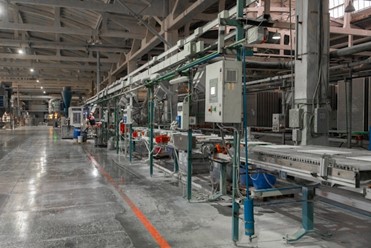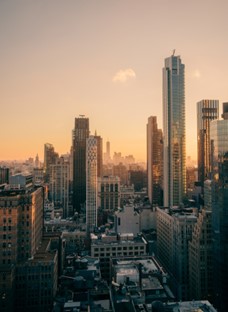
Industrial real estate has experienced a remarkable surge in demand, largely driven by the rapid growth of e-commerce and the increasing need for efficient logistics networks. As online shopping becomes an essential part of consumers’ daily lives, businesses, including land development companies, are working to meet the rising expectations for faster delivery times, broader product availability, and enhanced customer service. This has led to a dramatic shift in the way goods are stored, processed, and delivered, placing logistics hubs at the center of the supply chain. This article explores the factors driving the growth of industrial real estate and mixed-used spaces that are now reshaping urban landscapes, fostering economic growth, and meeting the evolving demands of businesses and communities.
The E-commerce Boom and Its Impact on Industrial Real Estate
The e-commerce sector has seen explosive growth in the past decade, a trend that was further accelerated by the global pandemic. According to the U.S. Census Bureau, e-commerce sales grew by more than 30% in 2020 alone, and this shift is showing no signs of slowing down. As consumers increasingly rely on online shopping for everything from groceries to electronics, the need for efficient fulfillment systems has become paramount for retailers and logistics providers. Meeting this demand requires a vast network of warehouses, distribution centers, and last-mile delivery hubs to ensure products are delivered quickly and reliably.
In response, developers are experiencing unprecedented demand for strategically located facilities near population centers, transportation hubs, and major distribution routes. Moreover, mixed-use developments are playing an increasingly significant role in this transformation by integrating industrial spaces with retail, residential, and office components, creating versatile hubs that maximize efficiency while meeting the diverse needs of modern urban environments.
The Growing Need for Logistics Hubs
With the rapid growth of e-commerce, the demand for large-scale, strategically located warehouses and distribution centers has skyrocketed.
Mixed-use developments have also become a part of this solution by blending industrial spaces with retail, office, and even residential components. These versatile developments not only optimize the use of limited urban space but also create dynamic environments where logistics hubs coexist seamlessly with other facilities, improving accessibility and fostering community integration. As a result, mixed-use logistics developments are emerging as a key innovation in addressing the growing needs of the e-commerce sector.
There are several key factors that contribute to the rising demand for industrial real estate:
Faster Delivery Expectations: As consumers grow accustomed to fast, often same-day or next-day delivery, retailers are under pressure to streamline their supply chains to meet these demands. To do this, they need to build or lease more warehouses and distribution centers, often in locations closer to urban areas to speed up the "last mile" delivery process.
Omnichannel Retailing: E-commerce companies are increasingly integrating their online and offline sales channels, creating a need for fulfillment centers that can handle orders from both online shoppers and physical stores. This shift towards omnichannel retailing requires retailers to build more sophisticated logistics networks to keep up with growing demand.
Inventory Management and Demand Fluctuations: The e-commerce model often requires retailers to carry more inventory in anticipation of fluctuating demand. This has led to an increase in the number and size of warehouses required to store large volumes of goods. Retailers are looking for larger distribution centers that allow for the storage of products closer to the consumer, reducing the time it takes to fulfill orders.
Supply Chain Resilience: The disruptions caused by the COVID-19 pandemic highlighted the vulnerabilities of global supply chains. As a result, many companies are looking to diversify and localize their supply chains by investing in domestic warehouses and distribution centers. This trend has prompted a further increase in demand for industrial real estate.
Trends in Warehouse and Distribution Center Development
The design and location of warehouses and distribution centers are being reimagined to incorporate new technologies, respond to customer expectations, and align with innovative business models. A notable trend is mixed-use spaces, which blend industrial spaces with residential, retail, and office components. Commercial development companies maximize land use, improve accessibility, and bring essential services closer to urban populations, creating more efficient supply chain networks. Below are some of the key trends shaping the future of warehouse and mixed-use commercial developments.
Automation and Robotics
Automation is revolutionizing the logistics industry, allowing for faster and more efficient operations. Automated systems, such as robotic pickers, conveyor belts, and autonomous vehicles, are increasingly being integrated into warehouses and distribution centers to improve speed, accuracy, and productivity. This trend is prompting developers to design facilities that can accommodate advanced technology, including higher ceilings, specialized infrastructure, and optimized layouts for robotic systems.
In addition to improving efficiency, automation helps companies address labor shortages by reducing the need for human workers in certain tasks. This is especially important as the demand for warehouse labor outpaces the available workforce in many regions.
Sustainability and Energy Efficiency
Sustainability has become a key focus in industrial real estate development. E-commerce companies and logistics providers are under pressure to reduce their environmental impact, and the real estate industry is responding by integrating sustainable design elements into warehouses and distribution centers. Features like energy-efficient lighting, solar panels, green roofs, and electric vehicle charging stations are becoming standard in new developments.
Furthermore, developers are increasingly designing facilities with lower carbon footprints, focusing on reducing energy consumption and utilizing renewable energy sources. Green building certifications such as LEED (Leadership in Energy and Environmental Design) are becoming more common as companies strive to meet their sustainability goals.
Strategic Location Selection
Location is crucial for logistics hubs. Developers are focusing on building industrial real estate in regions that offer easy access to major highways, ports, airports, and railways, reducing transportation costs and ensuring fast delivery times. Proximity to dense population centers is especially important for "last mile" fulfillment, as it allows goods to be delivered quickly and efficiently to consumers.
As urbanization continues, developers are increasingly building warehouses and distribution centers in suburban and even urban areas. This shift to closer proximity to cities helps retailers meet growing consumer demand for fast delivery and capitalizes on the increasing trend of urban sprawl.

Cold Storage Facilities
With the growth of online grocery shopping and the rise of perishable goods sales, cold storage warehouses have become a critical component of the logistics landscape. Developers are increasingly focusing on building temperature-controlled facilities for the storage and distribution of perishable goods such as food, pharmaceuticals, and medical supplies. These specialized warehouses require sophisticated refrigeration and climate control systems, and their growing demand is contributing to the overall increase in industrial real estate development.
Challenges
While the rise of e-commerce and logistics has spurred demand for industrial real estate, there are several challenges that developers and investors must navigate:
Land Availability: Prime locations near urban centers are in high demand, making it difficult for developers to find large plots of land for new projects. Additionally, zoning laws and local regulations can create obstacles for the construction of new logistics hubs.
Rising Costs: The growing demand for industrial real estate has led to higher land prices, construction costs, and labor expenses. Developers must balance these increased costs with the potential for long-term profitability.
Labor Shortages: As warehouses become more automated, the need for skilled labor is growing. However, finding workers with the necessary expertise to operate and maintain advanced technology can be a challenge in certain regions.
The Future
The demand for industrial real estate and mixed-use spaces continues to grow at an unprecedented pace. With the expansion of e-commerce and the increasing importance of logistics in the global supply chain, the industrial real estate market is set for sustained growth. A key development in this space is the rise of mixed-use projects, which integrate industrial facilities with retail, residential, and office spaces. These innovative developments optimize land use, bring essential infrastructure closer to urban centers, and create dynamic, multi-functional environments that cater to both business and community needs.
As technology, sustainability, and location considerations evolve, developers must adapt to meet the changing demands of retailers, logistics providers, and consumers. Industrial and mixed-use developments will remain critical pillars in the infrastructure supporting e-commerce, shaping how goods are stored, distributed, and delivered for years to come.

No comments.